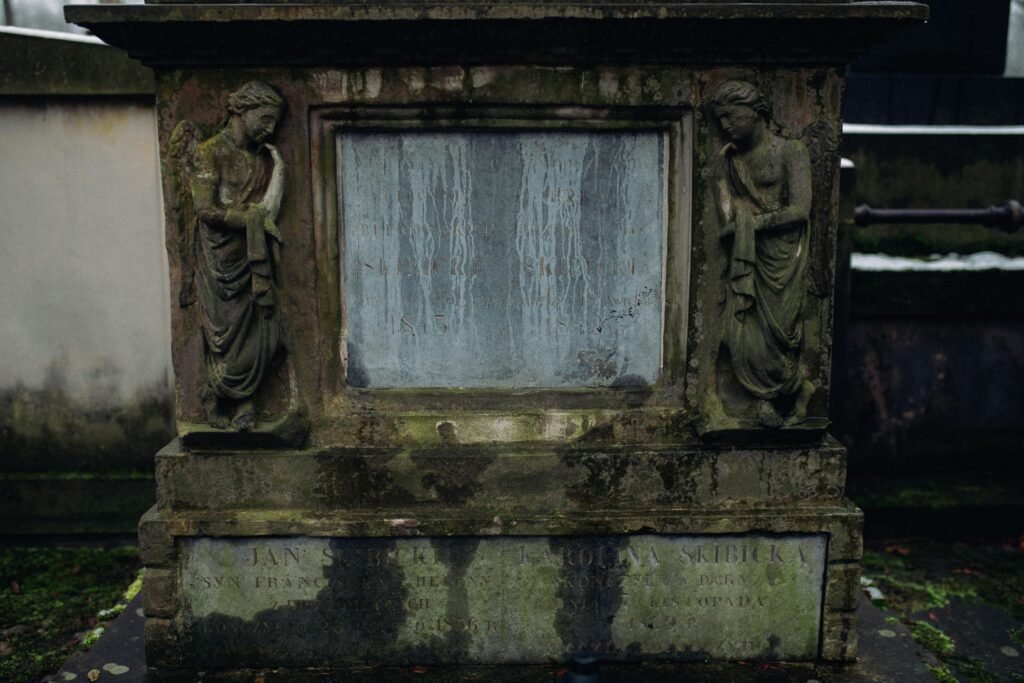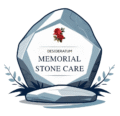How to Safely Remove Moss and Lichen from Headstones
Moss and lichen are some of the most common types of biological growth on gravestones. While they may seem harmless, they can trap moisture, erode inscriptions, and eventually weaken the stone. But cleaning them off incorrectly can cause more harm than good.
In this guide, you’ll learn how to safely remove moss and lichen from headstones using proven methods approved by cemetery preservation experts.

Why Moss and Lichen Grow on Headstones
Headstones are usually made of porous stone—like marble, granite, or sandstone—which absorbs moisture. When a gravestone is in a shady, damp area, conditions become perfect for moss and lichen to take hold.
They attach firmly to the surface, especially in engraved areas, and hold onto water, which leads to further staining, deterioration, and sometimes cracking.
Why You Shouldn’t Scrape or Power Wash
Many people think power washing or scraping with metal tools will remove the growth faster. While that’s technically true, these methods also:
- Scratch or chip the stone surface
- Remove inscriptions and detailing
- Force water deep into the stone
- Lead to irreversible damage
The best method is slow, gentle cleaning using proper tools and cleaners.
Tools You’ll Need
- D/2 Biological Solution or Orvus WA Paste
- Soft-bristle brushes (natural or nylon)
- Plastic or wood scraper (optional, for thick growth)
- Distilled water
- Pump sprayer or spray bottle
- Gloves (optional for sensitive skin)
Avoid anything abrasive or acidic. No bleach, vinegar, wire brushes, or power washers.
Step-by-Step Guide: Cleaning Moss and Lichen
Step 1: Wet the Headstone Thoroughly
Use clean water to saturate the entire stone. This softens the growth and protects the stone from absorbing cleaners too quickly.
Step 2: Apply Cleaning Solution
Spray D/2 Biological Solution onto the affected areas. Let it sit for at least 10–15 minutes. For heavy growth, you can leave it on longer.
Step 3: Gently Scrub
Use your soft-bristle brush to work the cleaner into the surface. Focus on the moss and lichen, brushing in circular motions. Don’t apply heavy pressure.
Step 4: Rinse Thoroughly
Use more clean water to rinse the stone. It may take several passes to remove all residue and loose growth.
Step 5: Let It Work Over Time
One of the advantages of D/2 is that it continues to work after application. Within 1–2 weeks, you may notice more growth sloughing off naturally. This is normal.
How Often Should You Clean?
In most cases, cleaning once a year is enough to keep biological growth under control. Over-cleaning, even with safe solutions, can wear down old or delicate stones.
Important Safety and Preservation Tips
- Always check cemetery rules before cleaning
- Avoid cleaning in extreme heat or direct sun
- Never clean unstable or leaning headstones
- Don’t try to fix cracks or structural damage yourself
For anything beyond surface cleaning, it’s best to hire a restoration specialist.
Final Thoughts
Moss and lichen may seem like minor issues, but they can slowly degrade a headstone over time. The key to cleaning is patience and the right products. Avoid harsh tools and chemicals. Stick with a soft brush, D/2 Biological Solution, and a gentle hand.
This approach will restore the appearance of your loved one’s headstone while preserving the integrity of the stone for years to come.
FAQ: Removing Moss and Lichen from Gravestones
Can I remove moss from a headstone without chemicals?
Yes. You can use just distilled water and a soft brush to remove light growth. However, for heavier buildup, a product like D/2 is more effective and safe.
Will the moss come back after cleaning?
Yes, especially in shaded, damp areas. Regular annual cleaning and trimming back surrounding plants can help prevent regrowth.
Is it safe to use a pressure washer on lichen?
No. Pressure washing will damage the stone surface, especially on older or softer materials like marble. Use manual cleaning methods instead.
What is the fastest way to remove lichen from a gravestone?
There’s no safe “fast” method. Apply D/2, let it dwell, and gently scrub. It may take a couple of cleanings, but this method protects the stone.
